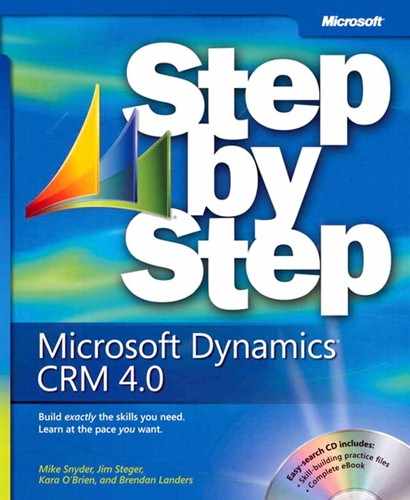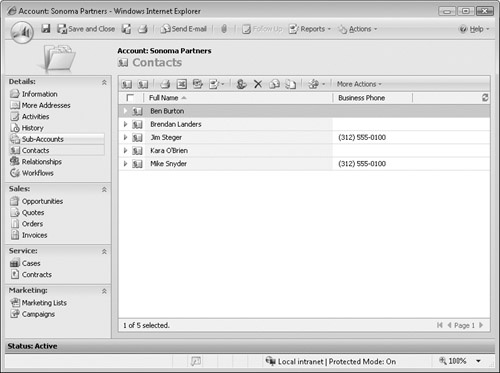Contacts represent the various people with whom you do business. For each contact record, you can specify one (and only one) account as its parent customer. Most companies use the Parent Customer field to record the contact’s employer, but you are not obligated to do so.
By specifying a parent customer for a contact, you create a relationship between those two records. When you create relationships between accounts and contacts, you can view all of an account’s contacts by clicking the Contacts link in the account’s left navigation pane. This list of contacts related to the account is known as the contact associated view.
Similar to linking sub-accounts and parent accounts, linking contacts to an account allows you to view the contacts related to an account, including a roll-up of the activities from the related contacts to the parent account. Therefore, if you log a phone call activity with the Mike Snyder contact record, whose parent account is Sonoma Partners, you will be able to view that phone call record when you’re looking at the Sonoma Partners record.
Tip
By default, Microsoft Dynamics CRM lists the contact’s full name and business phone number when you’re looking at the contacts related to an account. Your system administrator can customize this contact associated view to include additional columns, such as title, city, or e-mail address.
As with accounts, you can use several methods of creating a contact, such as the following:
Create a contact from the application menu toolbar by clicking New Record and selecting Contact.
Create a contact by navigating to a contact view and clicking the New Contact button in the grid toolbar.
Create a contact by clicking the New Contact button in the grid toolbar of the contact associated view of an account.
Create a contact by clicking the New button in the contact’s Look Up Records dialog box.
One benefit of creating a contact from the contact associated view is that Microsoft Dynamics CRM automatically populates several fields on the contact record, based on the account record you’re currently viewing. For example, if you have the Sonoma Partners account record open and you then click the New Contact button in the contact associated view, Microsoft Dynamics CRM fills out many of the fields on the new contact record—Street 1, Street 2, City, Business Phone, and others—with data from the Sonoma Partners account record. Microsoft Dynamics CRM also automatically fills out the Parent Customer field of the new contact as Sonoma Partners. This concept of populating data fields is known as field mapping. Your system administrator can determine how fields are mapped between two types of records.
Tip
Creating a new contact from the contact associated view automatically fills out the mapped fields, such as the Parent Customer field and the address fields. Using this technique saves you time if the contact shares the same address information with the account.
If you create a new contact record by using one of the first two methods described previously, Microsoft Dynamics CRM will not automatically fill out the mapped fields for you. This can be useful when the contact has different address information than the account (as could be the case when an employee works from home).
Although field mapping populates the contact record with data from the parent account, it will not maintain an ongoing link between the two records. If the account address changes because the business moves to a new office, you will need to explicitly update the address of the contacts related to that account. The bulk edit feature located on the More Actions menu on the grid toolbar of the contact associated view allows you to update the address of multiple contacts at the same time.
For each account record, you can specify a primary contact. As you would expect, the primary contact denotes the individual that your organization should initiate interactions with. Although most of the time the primary contact works for the account as an employee, this is not a requirement. You can select any contact in the system as the primary contact for an account. Consequently, assigning a primary contact to an account does not automatically map the data fields and populate the mapped values.
In this exercise, you will create two new contacts for the Sonoma Partners account. First, you will create a contact from the contact associated view, which will populate certain values in the contact. Then you will use a different method, in which Microsoft Dynamics CRM does not populate the mapped fields.
Note
USE the Sonoma Partners account record you created earlier in this chapter.
BE SURE TO use the Internet Explorer Web browser to navigate to your Microsoft Dynamics CRM Web site, if necessary, before beginning this exercise.
Navigate to Accounts and open the Sonoma Partners record.
In the left navigation pane, click the Contacts link.
In the grid toolbar, click the New Contact button.
Microsoft Dynamics CRM opens a new window. Note that the following fields already contain data: Parent Customer, Street 1, City, and State/Province.
In the First Name field, enter Ben, and in the Last Name field, enter Burton.
The Ben Burton contact now appears in the contact associated view of the Sonoma Partners account record.
Click the New Records menu item in the application menu bar, and select Contact to launch the New Contact form.
In the First Name field, enter Alan, and in the Last Name field, enter Jackson.
In the Parent Customer field, enter Sonoma Partners, and then press
 .
.Click Save and Close.
Now both Ben Burton and Alan Jackson are linked to the Sonoma Partners account record, but Microsoft Dynamics CRM populated the mapped fields only in the Ben Burton record because you created it from the contact associated view.


